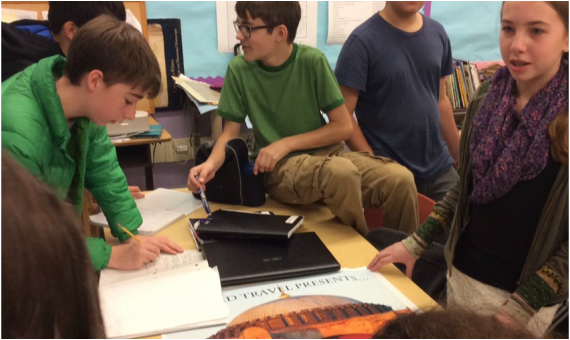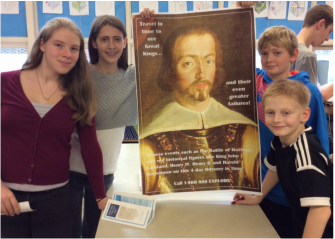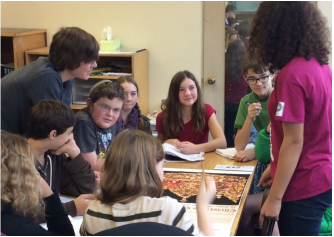| By Lucy Miller This week, teams finalized their Time Machine Projects, and presented to the rest of the school. Students gathered their Time Machine Passports and traveled in groups to each team, where they learned about specific events during the Dark Ages, categorized by different themes. Some prominent themes were Famous Women of the Middle Ages, A Day in the Life of a King, Cultural Innovations and The Science of Cathedral Building. Each team presented their 2-4 minute infomercial, a poster printed on the Large Format Printer, and a brochure. Team captains were also in charge of presenting a sales pitch, to sell their Travel Company to visitors. Some students even dressed up in business attire, to look even more professional and to sell their Time Travel package. If they didn’t succeed, their company would be shut down and they would be out of jobs! As students traveled to each room, they were encouraged to pay attention to all of the good things that happened in the Dark Ages. Afterwards, each team wrote a detailed informative essay about the Dark Ages, asking this important question: Were the Dark Ages really dark? Most students came to the conclusion that the Dark Ages were not as dark as they seem, and they were really filled with many important scientific, artistic, and literary advancements. |
|
0 Comments
By Owen For the TIME MACHINE project, each team has to create a time travel package to Medieval Times based on a theme. One example includes the evolution of the legal system in the middle ages, which puts the “time tourist” at the signing of the Magna Carta one day and a visit to King Edward I’s Model Parliament the next. Each team member had to create and plan a day in history around a big event. That member has to do a planning page, create an itinerary, make a flyer with images and other information. The team had to write and film an infomercial, with each day explained. The team also had to make a brochure, with 6 panels. Each team also had to make a poster, with a special template for a 24 by 36 inch poster on the new large format printer, an HP Designjet T120. It prints to all regular paper sizes up to 13 X 19 as well as a 24 inch roll banner print. The printer was provided by a grant from Donors Choose and was funded by Chevron Oil. We found or made an image, and made that the main background. We then used text boxes for our headlines and slogans.  The victorious English The victorious English by Rachel and Eden This week, we learned about the Hundred years’ war, which took place between the French and the English between 1337 and 1453. This was not 100 years of full-on warfare, but there was only one cause that they were fighting for, and battles occurred every few years. One important battle in this war was the Battle of Crécy. In order to simulate and better understand this battle, we were divided into groups. ⅔ of the students were the French, who outnumbered the English in the real battle by at least 8,000 men. The other third were English. Rubber-band slingshots were given to the French, as the French had standard weapons for that time. As English, we were given Nerf long bows and wooden slingshots to show how the English had great advances in technology. We donned science goggles as we began the battle. As the French marched into the classroom, we realized how badly outnumbered we were—in the Battle of Crécy, the French outnumbered the English by nineteen to seven. However, numbers proved to be of little help against the advanced technology of the English. As the French marched forward, they were hit by foam pellets and ping-pong balls, and they realized that they did not stand a chance. The French attempted to flee, but with Mr. Damon blocking the way, the casualties were numerous and often. By modeling this experience in our classroom, we realized that even if you are outnumbered by an enormous force, long bows can prove to be very efficient. The French may have believed that they were marching to victory, but brute strength a victor does not make. |
Archives
September 2015
Categories |




 RSS Feed
RSS Feed
